
Damselflies are insects of the suborder Zygoptera in the order Odonata. They are similar to dragonflies, which constitute the other odonatan suborder, Anisoptera, but are smaller and have slimmer bodies. Most species fold the wings along the body when at rest, unlike dragonflies which hold the wings flat and away from the body. An ancient group, damselflies have existed since at least the Lower Permian, and are found on every continent except Antarctica.

Enallagma cyathigerum is a species found mainly between latitudes 40°N and 72°N; It is widely distributed in the Palearctic, and the Nearctic species Enallagma annexum was at one time considered to be synonymous with it. The species can reach a length of 32 to 35 mm. It is common in many different countries including Russia, Europe and South Korea. Damselflies are an important link between the health of the aquatic ecosystem and its response to climate change.
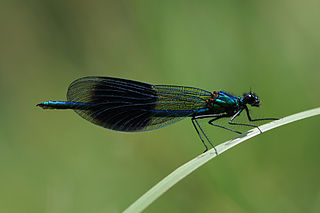
The banded demoiselle is a species of damselfly belonging to the family Calopterygidae. It is often found along slow-flowing streams and rivers. It is a Eurasian species occurring from the Atlantic coast eastwards to Lake Baikal and northwestern China.

The blue-tailed damselfly or common bluetail is a damselfly, belonging to the family Coenagrionidae.

The Irish damselfly or crescent bluet is a damselfly found in northern Europe and Asia to north-eastern China;. It is common and widespread in northern Finland, scarce and local in the Netherlands and Ireland and rare elsewhere. One of its English name comes from the fact that it is found in Ireland but not in Britain. The alternative name, crescent bluet, refers to the shape of the markings on segment two of the male and its scientific name.

The azure damselfly is a species of damselfly found in most of Europe. It is notable for its distinctive black and blue colouring. They are commonly found around ponds and lakesides during the summer.

Ischnura senegalensis, also known variously as common bluetail, marsh bluetail, ubiquitous bluetail, African bluetail, and Senegal golden dartlet, is a widespread damselfly of the family Coenagrionidae. It is native from Africa, through the Middle East, to southern and eastern Asia.

Erythemis simplicicollis, the eastern pondhawk, also known as the common pondhawk, is a dragonfly of the family Libellulidae, native to the eastern two-thirds of the United States and southern Ontario and Quebec, Canada. It is a dragonfly of ponds and still waters. The species is distinguished in that the female is bright green with a banded abdomen and the mature male has a blue abdomen with a green face and green and blue thorax.

Somatochlora, or the striped emeralds, is a genus of dragonflies in the family Corduliidae with 44 described species found across the Northern Hemisphere.
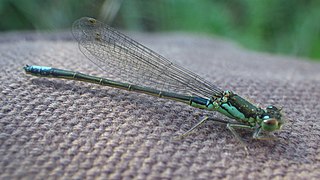
Ischnura gemina is a species of damselfly in the family Coenagrionidae known by the common name San Francisco forktail. It is endemic to the San Francisco Bay Area in California in the United States. This uncommon insect has a total range of less than 500 square miles in the Bay Area, occurring only in greater San Francisco and parts of San Mateo and Marin Counties. This species is "one of the rarest Odonates in the United States."
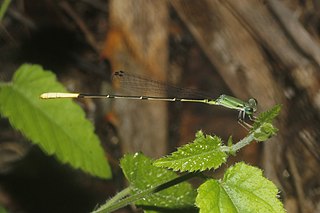
Leptobasis is a small genus of damselflies in the family Coenagrionidae. They are commonly known as swampdamsels. The genus is neotropical and one species, L. melinogaster, has been recorded in Texas. They are slender and the females have very long ovipositors.
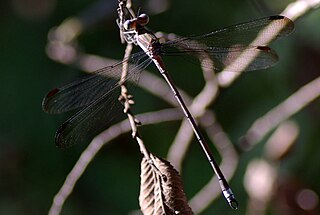
The great spreadwing is a damselfly in the family Lestidae. When great spreadwings are startled they often return to the same perch or a perch nearby.

Eastern forktail is a member of the damselfly family Coenagrionidae.
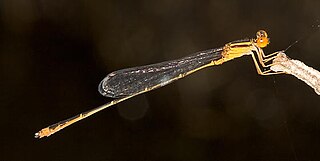
The orange bluet is a species of damselfly in the family Coenagrionidae.
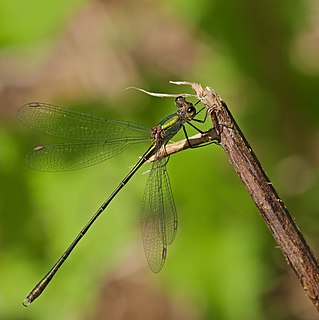
Chalcolestes viridis, formerly Lestes viridis, is a damselfly of the family Lestidae. It has a metallic green body and at rest it holds its wings away from its body. Its common name is the willow emerald damselfly or the western willow spreadwing.

The blue-fronted dancer is a species of damselfly in the family Coenagrionidae, native to parts of North America. It was first described by the American zoologist Thomas Say in 1840. It is a common species with a wide range and the International Union for Conservation of Nature has assessed its conservation status as being of "least concern".
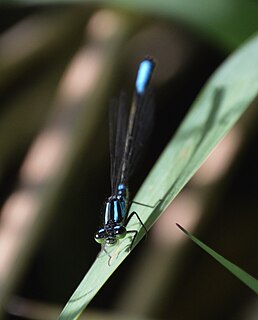
Ischnura erratica, the swift forktail, is a species of damselfly in the family Coenagrionidae. It is native to the Pacific Northwest, ranging from British Columbia to northern California.
Neoneura amelia, commonly known as Amelia's threadtail, is a species of damselfly in the family Protoneuridae. It is native to the southern United States and Central America, its range extending from the southern tip of Texas to Panama.
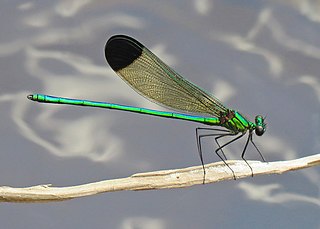
The sparkling jewelwing is a species of damselfly in the family Calopterygidae. It is endemic to the eastern and southeastern United States. Its natural habitat is woodland and open areas near forest rivers and streams.

Paracercion calamorum, the dusky lilysquatter, is a species of damselfly in the family Coenagrionidae. It has a range that extends from southern far-eastern Russia to Japan, and to India and Indonesia. The nominate subspecies P. c. calamorum is known from central and eastern China, Korea and Japan. The subspecies P. c. dyeri occurs in southern China, Hong Kong, Taiwan, Indonesia, India, Nepal, and Thailand.




















